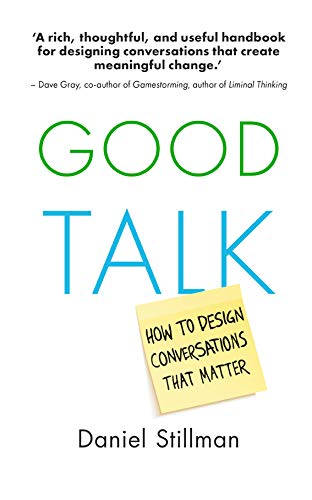Podcast #634: How to Design Conversations That Matter
Description
We typically don’t think much about how we structure a conversation. We just sort of wing it and hope for the best. But my guest today argues that all conversations — even the small and mundane — can impact our ability to lead, influence, and connect, and ought to be approached with thoughtfulness and intention.
His name is Daniel Stillman, he’s a consultant, author, and podcaster, and in his book Good Talk: How to Design Conversations That Matter, he draws on his background in design to show how we can use the principles of design thinking to improve the quality of our exchanges. Daniel and I kick off our discussion by unpacking the defaults of conversation people often fall back on. Daniel compares the structure of conversation to an operating system, and we turn to how we can improve this conversational OS, beginning with the way we invite people into a conversation with us, and why we shouldn’t just ask, “Can we talk?” We then get into how we can improve the “interface” of our conversations, by recognizing the influence that space and place have on them, and choosing the right environment for a particular dialogue. We end our conversation with the options you have for responding when it’s your turn to talk and how to deal with the gaffes we all make during conversations, and the feelings of regret that frequently follow.
If reading this in an email, click the title of the post to listen to the show.
Show Highlights
- The conversational defaults that may not be working for people
- What to do if you’re the “fixer” type of conversationalist
- How to approach a hard conversation
- Making an honest invite to a conversation
- The ways we teach people to treat us
- How the space and the place affects our conversations
- The need to sometimes re-invite someone into a conversation
- How to elicit more from the people we’re conversing with
- Why you don’t need to have a hot take on everything
Resources/People/Articles Mentioned in Podcast
- The Power of Conversation
- How to Avoid Conversational Narcissism
- How to Start and Sustain Conversations
- How Conversation Builds Character
- Reclaiming Conversation
- The Art of Conversation: 5 Do’s and Don’ts
- The Fearless Organization
- How a Weekly Marriage Meeting Can Strengthen Your Relationship
- How to Deal With Life’s Regrets
Connect With Daniel
Listen to the Podcast! (And don’t forget to leave us a review!)
Listen to the episode on a separate page.
Subscribe to the podcast in the media player of your choice.
Listen ad-free on Stitcher Premium; get a free month when you use code “manliness” at checkout.
Podcast Sponsors
Click here to see a full list of our podcast sponsors.
Read the Transcript
Brett McKay: Brett McKay here, and welcome to another edition of The Art of Manliness Podcast. We typically don’t think much about how we structure a conversation, we just sorta wing it and hope for the best. My guest today argues that all conversations, even the small and mundane, can impact our ability to lead, influence, and connect, and ought to be approached with thoughtfulness and intention. His name is Daniel Stillman, he’s a consultant, author, and podcaster, and in his book “Good Talk: How to Design Conversations That Matter,” he draws on his background of design to show how we can use the principles of design thinking to improve the quality of our exchanges.
Daniel and I kick off our discussion by unpacking the defaults of conversation people often fall back on, and then Daniel compares the structure of conversation to an operating system, and we turn to how we can improve this conversational OS, beginning with the way we invite people into a conversation with us and why we shouldn’t just ask, “Hey, can we talk?” We then get into how we can improve the interface of our conversations by recognizing the influence that space and place have on them and choosing the right environment for a particular dialogue, and we end our conversation with the options you have for responding when it’s your turn to talk and how to deal with the gaffes we all make during conversations and the feelings of regret that frequently follow. After the show is over, check out our show notes at aom.is/conversationdesign.
right, Daniel Stillman, welcome to the show.
Daniel Stillman: Thanks for having me, Brett. I’m stoked, really.
Brett McKay: So you’re a designer who went to industrial school, and now you help people and companies apply the principles of design thinking that can be used to design products, to even designing better conversations. And one of the first thing that design thinkers do is figure out the default ways humans use a product, a service, a system. Let’s apply this to conversations. What are some of the defaults of conversation that may not be working for people?
Daniel Stillman: Yeah, so first of all, I struggled with this in writing my book, ’cause I really want people to be reflective practitioners of their conversations, ’cause most of us can’t remember learning how to talk. You might remember learning how to play chess, and maybe you got better at it, you learned some strategies. I think most of us are working with a patched-together system, like we’re magpies, we just… We saw something that we thought worked, and so we copied that and maybe it worked for us. And so, I think we’re just… We’re flying blind with a bunch of duct tape over the thing. So I think it’s really up to everyone else to ask themselves, what do I want? Is what I’m doing working? And if it is, don’t











